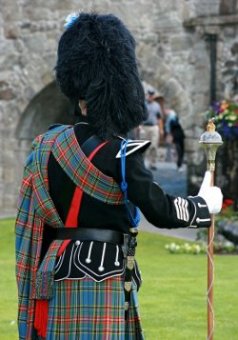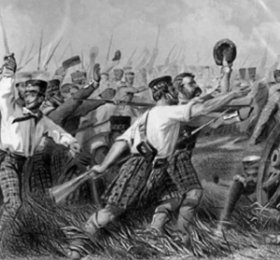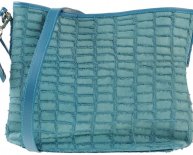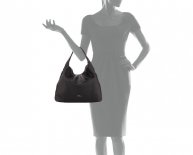
Sporran meaning
 about nationwide costume, we don't believe there is something that can match Scottish kilts!
about nationwide costume, we don't believe there is something that can match Scottish kilts!
They truly are colorful, unique, stylish... and merely plain cool!
Even though it's not only we Scots who can set claim towards the kilt as a type of national gown, old-fashioned kilts are acknowledged across the world as a symbol of Scotland.
Inside it's many original form, the kilt had been a piece of clothes exclusively worthy of the useful requirements of Highlanders, and might have it's roots into the variety of garments donned by the numerous invaders who landed on Scottish earth so long ago.
It has changed a great deal since, is now frequently seen at ceremonies and official occasions which range from weddings to military processions.
The Foundation Of The Scottish Kilt
The kilt you are witnessing in your head's eye is very distinct from the first clothes donned by Scots those centuries ago.
Although of Celtic tradition today, initially the term 'kilt' may have come from the Nordic term 'kjalta', very first taped in the 9th century.
At the beginning of it's record, Scotland had been occupied by several nations (including Romans, Vikings and Scandinavians). 'Old Norse' ended up being the first language of Scandinavians.
These invaders all clothed differently, in a variety of tunics, robes, t-shirts and cloaks. It is not clear precisely how the kilt evolved but it's believed that it's a variety of each one of these, modified to suit the environment and way of life associated with robust, warlike inhabitants of this Scottish Highlands.
During the 16th century, the very first Scottish Kilts known as 'Feileadh Mhor' (definition 'Great Kilt' and pronounced 'feela mor') appeared, and so are in addition regarded now while the 'belted plaid'.
 * Spoiler alarm * Although Mel Gibson wears a fantastic Kilt inside movie Braveheart, in fact these did not exist throughout the 13th century (the schedule the movie signifies).
* Spoiler alarm * Although Mel Gibson wears a fantastic Kilt inside movie Braveheart, in fact these did not exist throughout the 13th century (the schedule the movie signifies).
The Annals Of Scottish Kilts
Right here we will start with the fantastic Kilt (or Belted Plaid).
Usually the Feileadh Mhor had been produced from one period of a thick, wool fabric called 'breacan' (a Gaelic term meaning speckled or partially colored). This fabric ended up being typically about 5ft large and may be up to 21ft very long.
A few legs regarding the material had been folded into loose pleats and covered across the wearers' waist, then fastened set up with a dense, leather belt.
All of those other fabric ended up being tossed within the shoulder, and tucked in to the gear behind.
This extra product is also pulled up over the top and shoulders to safeguard anyone who ended up being using it from cool winds, and heavy rainfall or snow. The whole thing ended up being worn over an extended sleeved tunic, which reached the knees.
Over a hundred years later, all over center of seventeenth Century this early, heavy and rather awkward, version of the kilt began to be replaced by the 'Feileadh Beag' (also known as the 'Philabeg' and pronounced 'feela beg').
This is simply the lower half the Feileigh Mor and contained an individual (shorter) duration of breacan, loosely collapsed, covered around the waistline and again guaranteed by a thick gear.
There is no 'extra' fabric to throw-over the shoulder or use as a cloak, which variation has also been referred to as 'Walking Kilt'.
In eighteenth Century, the loose folds had been extensively being changed by pleats that were sewn in to the material, making your whole outfit easier to wear.
For a time both designs were worn by Highlanders, but with time the older Great Kilt vanished from each day wear because the more comfortable Walking Kilt took it really is location .
By this point ever sold it absolutely was a whole lot more familiar as ancestor of today's kilt.
The Scottish Kilt Is More Than Just An Ensemble!
Scottish Highlanders had been strong, proud and intensely patriotic and historically the kilt had been alot more than a flexible piece of garments, it absolutely was emblematic of these history.
For centuries the English was in fact trying, mostly unsuccessfully, to subdue the uncontrollable inhabitants of the wild land, together with humble kilt became a casualty of this conflict.
For their attachment to it, therefore the fact that the kilt considered a rebellious symbolization, it absolutely was banned because of the 'Dress Act' (an element of the 'Act of Proscription') imposed by King George II in 1746
Obviously, some Scots decided to merely overlook the ban and proceeded to put on the kilt in protest.
Human nature becoming exactly what it's, this make an effort to stamp down kilt-wearing in fact backfired and only served to make it more vital that you the patriotic Scots.
It's place as emblematic of Scottish culture and nationwide pride, rather than just the standard Scottish clothes donned by Highland clans, was cemented and proceeded to cultivate.

















